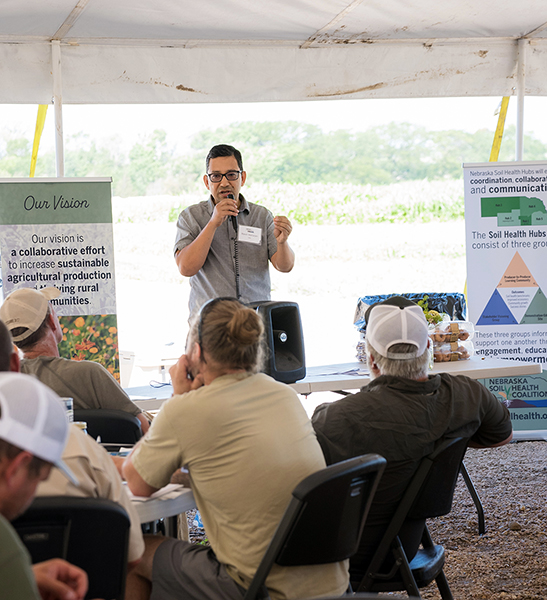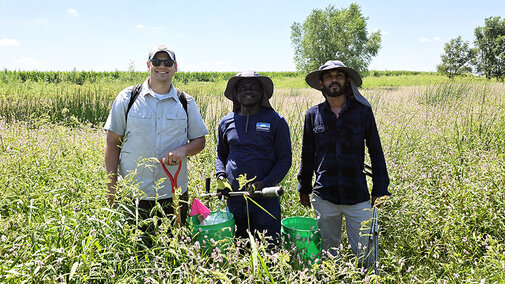The Nebraska Soil Health Coalition (NSHC), in partnership with Dr. Bijesh Maharjan at the University of Nebraska-Lincoln (UNL), is taking an important step toward understanding and improving the resilience of Nebraska’s soils.
NSHC has launched Hub 1, the first of five planned regional hubs to benchmark and monitor Nebraska’s soil health. This pilot site in south-central Nebraska will establish baselines to help producers, researchers and conservation partners track soil changes over time and make informed management decisions.
“The NSHC is pleased to pilot the first soil health benchmarking steps with Dr. Bijesh Maharjan in Hub 1 as a part of five eventual hubs across Nebraska,” NSHC Board Member Mike McDonald said. “The five sites are the basis of our long-term demonstration and education sites (DES) that integrate systemic education and build deep relationships. We are very pleased to partner with UNL and collaboratively develop a national model.”

This August, Maharjan and his team members — Dr. Godfred Ankomah and Dilshan Ekanayaka from UNL’s Panhandle Research, Extension and Education Center (PREEC) — joined Riley Hackbart from USDA Natural Resources Conservation Service (NRCS) to sample soil from five cropland-reference site pairs in four south-central Nebraska counties. These pairs allow researchers to compare working agricultural fields with nearby undisturbed sites that represent the region’s natural soil conditions.
“Benchmarking soil health is about more than just numbers — it’s about creating a reliable foundation so we can measure progress in years to come,” said Maharjan, UNL associate professor in soil science and agronomy. “By comparing croplands with their reference sites, we are able to see how management practices are influencing soil organic matter, nutrient cycling, microbial activity, and other key indicators of soil function.”
Spearheading the initiative, NSHC is a farmer-led group dedicated to building farm resilience from the ground up. By promoting soil health awareness and education, and encouraging practices that improve soil function and profitability, NSHC works to ensure Nebraska’s land remains productive for future generations. Its mission is to unite producers, agricultural professionals, agencies, universities and industry partners to advance soil stewardship. The Hub 1 benchmarking effort exemplifies this collaboration, with Maharjan’s team, NRCS colleagues and local producers working side by side to generate knowledge that benefits all of Nebraska agriculture.
“The USDA NRCS is happy to support a grassroots-focused producer-led soil health coalition in the state,” USDA NRCS State Soil Scientist Carlos Villareal said. “Soil health benchmarking is a crucial part of the effort. Following Maharjan’s soil health benchmarking concept, published as Soil Health Gap, NRCS supports soil health benchmarking for any cropland through an incentive program.”
Led by Maharjan, the UNL team will be preparing a comprehensive report and developing extension materials tailored for farmers and conservation stakeholders. These outputs will help producers evaluate the impact of practices such as cover crops, reduced tillage and optimized nutrient management, giving them a clearer picture of how their soils stack up against natural baselines.
Soil health benchmarking in Hub 1 is part of a broader NSHC goal to create a statewide soil health monitoring and benchmarking network. The effort ensures that farmers, ranchers and policymakers have the science-based tools they need to balance productivity with long-term stewardship.
“Healthy soils are the foundation of Nebraska agriculture,” Maharjan emphasized. “By working together — producers, ag professionals, agencies, industries and universities — we can make sure that foundation remains strong for generations.”
More information on NSHC Hub 1 is available on the Nebraska Soil Health Coalition site.

